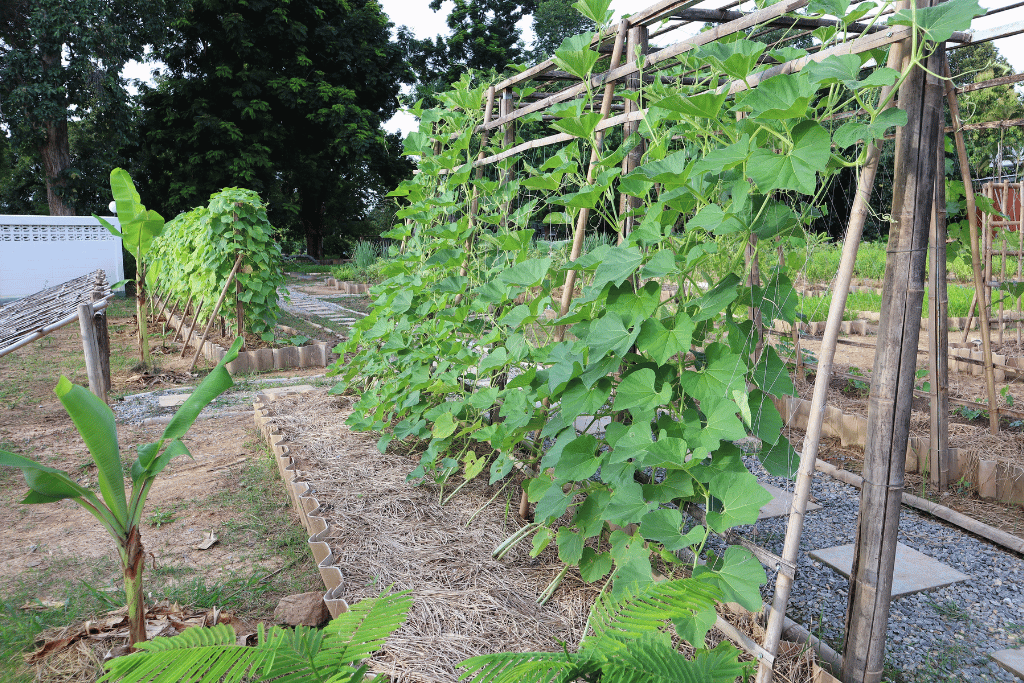
Zucchini is a popular summer squash, and people often wonder if they should use a trellis when growing it. To understand this, let’s learn more about zucchini. Zucchini is related to cucumbers, melons, and pumpkins.
Normally, zucchini plants grow like bushes and can reach 2-3 feet in height. But some types can get as tall as 6 feet. These plants produce big, green fruits, which are usually ready to pick when they’re 6-8 inches long.
So, does zucchini need a trellis? Well, zucchini plants can grow fine without one. They naturally spread out like bushes. But using a trellis can have benefits. It can save space in your garden because the vines go up instead of spreading all over. It might also help keep the fruits clean and away from pests.
The bottom line is, while zucchini doesn’t absolutely need a trellis, using one can be a good idea, especially if you have limited space or want to keep your garden neat. Let’s learn more about zucchinis on a trellis.
Zucchini Plants Overview
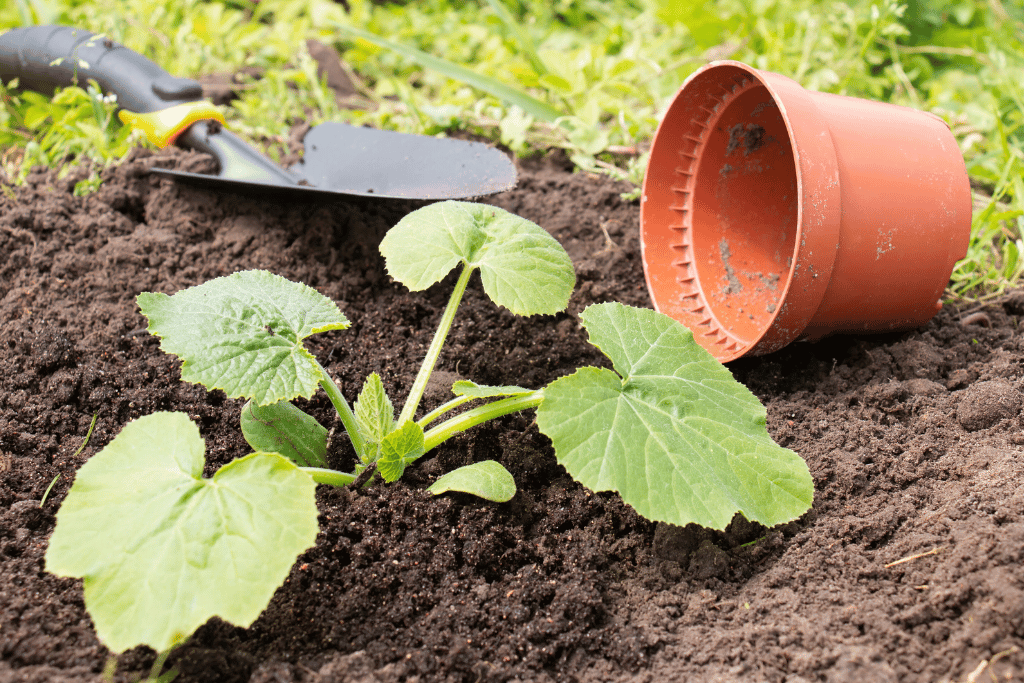
Growth Habits
Zucchini plants come in two main types based on how they grow:
Bush Varieties: These zucchinis grow like little bushes. They usually reach about 2-3 feet in height and spread out to about the same width. They’re pretty compact.
Vining Varieties: On the other hand, vining zucchinis are sprawlers. They can grow up to a tall 6 feet and spread out just as wide or even wider.
Size and Space Requirements
To make sure your zucchini plants grow well, you need to think about how much room they need. They really like sunlight and soil that drains well. Bush zucchinis are cool because you can grow them in pots or containers, which is great if you don’t have much space.
But if you’re growing vining zucchinis, you’ll need more space in your garden, and they do best when you plant them right in the ground. It’s also important to give them some breathing room. For bush zucchinis, leave about 2-3 feet between each plant.
Fruit Production
Zucchinis are famous for making lots of veggies. They keep giving you yummy zucchinis for several weeks during the growing season. You usually pick them when they’re about 6-8 inches long. You can eat them fresh, cook them in all sorts of dishes, or even freeze them to enjoy later.
So, back to the question: “Does zucchini need a trellis?” Well, zucchinis can do okay without one because they have different growth habits. But using a trellis can be handy, especially if you’re short on space or want to keep things tidy.
It’s more essential for vining zucchinis since they like to spread out a lot. For bush zucchinis, you can get away without a trellis, but it’s still a good idea if you want to save space and maybe protect your zucchinis from some pests.
Explore the long list of vine growing vegetables.
Choosing the Right Zucchini Variety for Trellising

When it comes to cultivating zucchini, gardeners often wonder, “Do zucchini need a trellis?” The answer is not a simple yes or no, as it depends on various factors, including the specific zucchini variety you plan to grow and the space available in your garden.
What You Need to Know About Zucchini Trellises
Before we get to the selection process, let’s discuss the concept of zucchini trellises. Zucchini trellises are vertical structures that support zucchini plants as they grow upward. While zucchini plants are not natural climbers like peas or cucumbers, they can benefit from trellising for several reasons. Trellising zucchini plants can help save space, improve air circulation, reduce disease risks, and make harvesting more accessible.
Do Zucchini Plants Climb?
The common misconception is that zucchini plants are climbers by nature. However, zucchini plants do not possess the natural inclination to climb. Instead, they are typically sprawling and can take up a considerable amount of horizontal space in your garden. To encourage them to grow vertically, you will need to provide them with a suitable trellis system.
Can You Grow Zucchini on a Trellis?
Yes, you can grow zucchini on a trellis, but the success of this endeavor depends on selecting the right zucchini variety. Not all zucchini varieties are equally suitable for trellising, as their growth habits can vary significantly. Therefore, choosing the appropriate zucchini variety is crucial for a successful trellising experience.
Factors to Consider When Choosing a Zucchini Variety for Trellising
- Vigor of the Vines: One of the primary considerations when selecting a zucchini variety for trellising is the vigor of the vines. Some zucchini varieties have more robust and upright growth habits, making them ideal candidates for trellising. Others may have shorter, bushier growth habits, which may not work as well with a trellis system.
- Size and Space: Assess the available space in your garden. If you have limited horizontal space but ample vertical space, trellising zucchini can be an excellent solution. However, make sure your chosen zucchini variety is well-suited for this vertical growth.
- Climbing Tendency: While zucchini plants don’t naturally climb, some varieties tend to exhibit more climbing behavior than others. Look for zucchini varieties that are more likely to send out tendrils or have a more upright growth pattern.
Zucchini Varieties Suited for Trellising
Several zucchini varieties are well-suited for trellising due to their vigorous growth habits and climbing tendencies. Here are some popular zucchini varieties to consider:
Black Beauty: Black Beauty zucchini is a classic variety known for its dark green, glossy fruits. It has a robust growth habit and can adapt well to trellising.
Cocozelle: Cocozelle zucchini is an Italian heirloom variety with attractive green-striped fruits. It tends to have more vertical growth and can thrive on a trellis.
Golden Zucchini: Golden zucchini, as the name suggests, produces vibrant yellow fruits. This variety often exhibits a more upright growth pattern, making it suitable for trellising.
Green Zebra: Green Zebra zucchini is another striped variety with a climbing tendency. Its unique appearance and climbing potential make it an interesting choice for trellising.
Patio Star: Patio Star zucchini is a compact variety designed for small spaces, but it can still benefit from trellising. Its bushy growth can be trained upward on a trellis.
Sunburst: Sunburst zucchini stands out with its beautiful yellow, scallop-edged fruits. It has a vigorous growth habit that can work well on a trellis.
The Role of Proper Support in Zucchini Cultivation
Supporting zucchini plants with trellises can significantly impact their growth and overall success. Let’s delve into why providing proper support is crucial in zucchini cultivation and explore the pros and cons of using trellises.
Benefits of Supporting Zucchini Plants
Supporting zucchini plants with trellises offers a multitude of advantages:
Improved Air Circulation: Trellises facilitate better air circulation around the plants. This improved airflow reduces the risk of pests and diseases that thrive in damp, crowded conditions.
Pest and Disease Management: Trellis zucchini plants are more accessible for inspection and treatment when pests or diseases strike. Detecting issues early and taking prompt action can help protect your crop.
Easier Harvesting: Growing zucchinis vertically on trellises makes harvesting a breeze. The fruits are conveniently within reach, sparing you the need to crawl through tangled vines.
Space-Saving: Trellises efficiently utilize garden space. They allow zucchini plants to grow upward instead of sprawling horizontally, making them an excellent choice for smaller gardens or areas with limited space.
What Potential Issues Can a Zucchini Plant Face Without Support
Zucchini plants that are left unsupported may face several challenges:
Increased Susceptibility to Pests and Diseases: When zucchini plants grow close to the ground, they are more vulnerable to pests and diseases that thrive in soil contact.
Reduced Fruit Production: Without proper support, zucchini plants may produce fewer fruits. The lack of airflow and increased competition for resources among sprawling vines can hinder fruit development.
Smaller and Irregularly Shaped Fruits: Unsupported zucchini plants may yield smaller and irregularly shaped fruits due to limited access to sunlight and nutrients.
Higher Likelihood of Wilting: On hot days, zucchini plants without support may wilt more easily, as their sprawling foliage can trap heat and moisture, stressing the plants.
How to Grow Zucchini on a Trellis
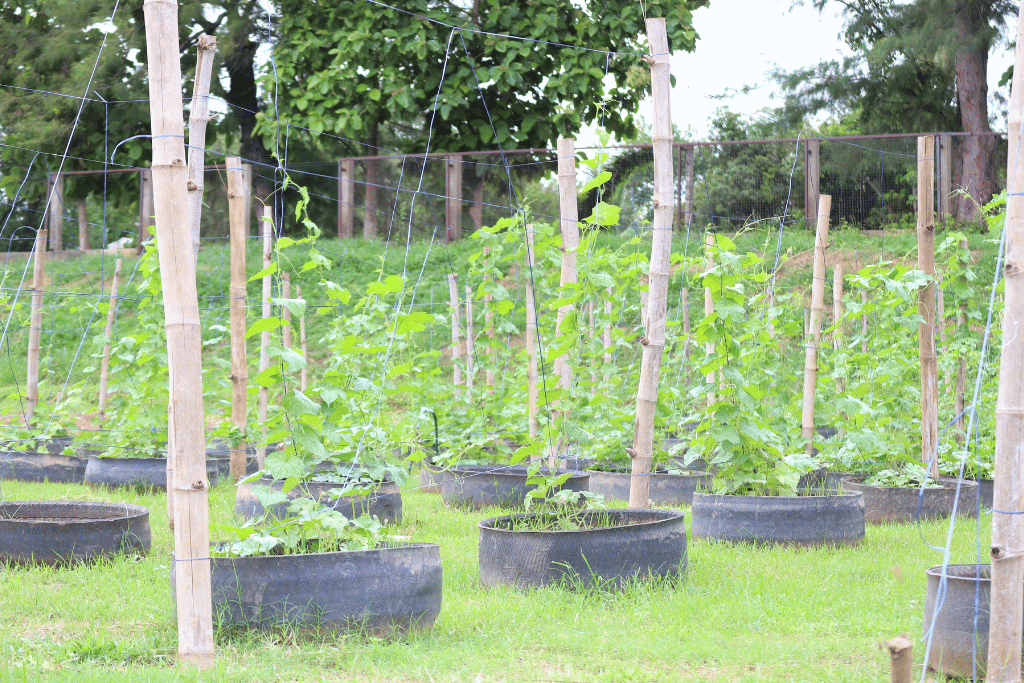
Growing zucchini on a trellis can be a space-efficient way to cultivate this versatile summer squash. Here’s how you can grow zucchini on a trellis:
Materials and Tools Needed
Here’s a list of what you’ll need:
Trellis Structure: The trellis serves as the backbone of your zucchini support system. It can be constructed from various materials, including wood, metal, or plastic. The choice of material largely depends on your budget and aesthetic preferences.
Strong Twine or Garden Tape: You’ll require durable twine or garden tape to secure the zucchini vines to the trellis as they grow. This ensures that the vines remain in an upright position and receive adequate support.
Watering Can or Hose: Adequate watering is crucial for zucchini plants, especially when they are trellised. Ensure you have a reliable watering can or hose to maintain consistent moisture levels in the soil.
Fertilizer: Zucchini plants benefit from regular feeding to support healthy growth and fruit production. Select a balanced fertilizer suitable for your gardening needs.
Pruning Shears: Pruning shears are essential for maintaining the health and shape of your zucchini plants. Regular pruning helps remove dead or diseased leaves and encourages the development of strong, productive vines.
Now that you’ve assembled your materials and tools, let’s dive into the step-by-step process of growing zucchini on a trellis.
Steps for Trellising Zucchini
1. Prepare the Trellis Structure
The first step in trellising zucchini is to select or construct an appropriate trellis structure. The trellis should be tall enough to accommodate the potential height of your zucchini plants but not so towering that it becomes challenging to reach the fruits when it’s time to harvest. Additionally, ensure the trellis is sturdy enough to support the weight of both the vines and the growing zucchini.
When choosing or designing your trellis, consider the following factors:
- Height: Zucchini plants can grow vigorously, so select a trellis that allows for vertical growth while maintaining accessibility.
- Sturdiness: Opt for a durable trellis material that can withstand the weight of mature zucchini plants and their fruits. Reinforce the trellis if necessary.
- Size: The size of the trellis should match the space you have available in your garden. It should be proportional to the number of zucchini plants you plan to trellis.
2. Plant Zucchini Near the Trellis
To facilitate efficient trellising, plant your zucchini seedlings or seeds near the trellis. Position them approximately 12 inches away from the base of the trellis. This initial spacing provides room for the zucchini plants to grow and establish themselves before they start climbing the trellis.
When planting zucchini, dig holes in the soil at the appropriate spacing, typically 2-3 feet apart, depending on the variety. Place the zucchini seedlings or seeds in the holes and cover them with soil. Water them thoroughly to ensure proper establishment.
3. Train the Zucchini Vines to Grow Up the Trellis
As your zucchini plants begin to grow, it’s crucial to guide the vines up the trellis. The goal is to train the vines to climb the trellis in an organized and orderly fashion. Here’s how to do it:
- Gently Secure the Vines: Using the strong twine or garden tape, gently secure the zucchini vines to the trellis as they grow. Start by loosely tying the vines to the trellis near the base of the plant.
- Regularly Monitor and Adjust: As the vines continue to grow, periodically check their progress and adjust the ties to ensure they remain properly supported. Avoid tying the vines too tightly, as this can damage the plants. Instead, provide gentle guidance to encourage upward growth.
- Encourage Vertical Growth: Whenever you see a zucchini vine veering off course or growing horizontally, gently redirect it upward by securing it to the trellis. The goal is to create a vertical growth pattern.
Trellising zucchini is a gradual process that requires patience and vigilance. Over time, the vines will adapt to their trellis support, and you’ll notice a more organized and efficient growth pattern.
4. Regularly Maintain and Prune the Zucchini Plants
To ensure the health and productivity of your trellised zucchini plants, it’s essential to perform regular maintenance and pruning. Here are some key maintenance tasks to keep in mind:
- Watering: Zucchini plants need consistent moisture, so be vigilant about watering. Check the soil regularly, and water when it begins to dry out. Deep, thorough watering is preferable to shallow, frequent watering.
- Fertilization: Feed your zucchini plants every few weeks with a balanced fertilizer. Follow the manufacturer’s instructions for application rates and timing. Fertilizing helps promote robust growth and abundant fruit production.
- Pruning: Regular pruning is a vital aspect of zucchini trellising. Remove any dead or diseased leaves from the zucchini plants as soon as you notice them. This practice helps maintain plant health and prevents the spread of diseases.
- Support for Growing Fruits: As zucchini fruits develop and grow, they can become heavy. To prevent the trellis from becoming overloaded and to support the fruits adequately, you can employ various methods:
- Netting: Place a net or mesh under the zucchini vines to catch the fruits as they mature. This prevents them from falling and potentially getting damaged.
- Slings: Create slings using fabric or netting and gently tie them around the growing zucchini fruits. These slings cradle the fruits, providing essential support.
- Bamboo Stakes: Position bamboo stakes near the developing zucchini fruits and use twine or garden tape to secure the fruits to the stakes. This method helps distribute the weight and prevent breakage.
Tips for Successful Zucchini Trellising
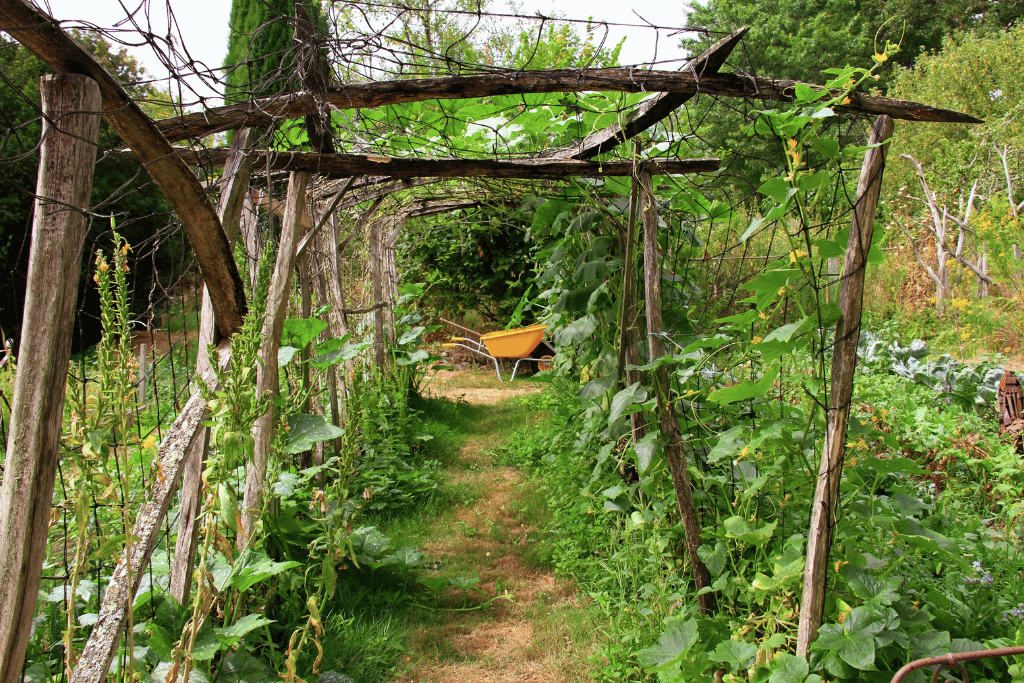
To further enhance the success of your zucchini trellising efforts, consider these valuable tips:
- Choose an Appropriate Trellis Structure: The trellis you select should be the right size and height for your zucchini plants. It should provide adequate support without hindering access for maintenance and harvesting.
- Proximity Matters: Position your zucchini plants close to the trellis to facilitate the training of the vines. A shorter distance between the plant and the trellis makes it easier to guide the vines upward.
- Gentle Tying: When securing the zucchini vines to the trellis, be gentle with your ties. Avoid tying too tightly, as this can damage the plants. The ties should provide support without constricting growth.
- Regular Watering: Zucchini plants thrive in consistently moist soil. Be diligent about watering, and aim to keep the soil evenly moist, but not waterlogged. A drip irrigation system or soaker hose can be beneficial for maintaining proper moisture levels.
- Fertilize Adequately: Apply a balanced fertilizer every few weeks to ensure your zucchini plants receive essential nutrients. Proper fertilization encourages robust growth and bountiful fruit production.
- Inspect for Pests and Diseases: Regularly inspect your zucchini plants for signs of pests or diseases. Early detection allows for prompt intervention and prevents issues from escalating.
- Prune Wisely: When pruning your zucchini plants, focus on removing dead or diseased leaves. Avoid excessive pruning, as this can reduce the plant’s ability to photosynthesize and produce energy.
- Maintain a Clean Garden Environment: Keep the area around your zucchini trellis clean and free of debris. A tidy garden reduces hiding places for pests and promotes good air circulation.
How Much Space do Zucchini Need if Using a Trellis
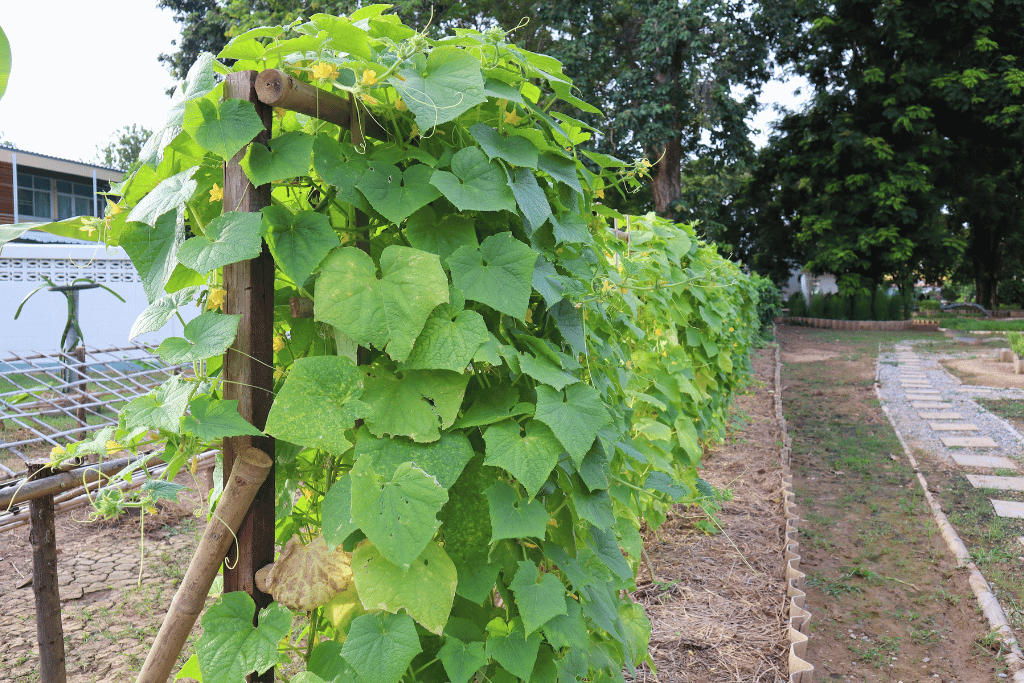
When growing zucchini on a trellis, you can save space compared to traditional ground planting. The amount of space required for zucchini on a trellis depends on the specific variety you’re growing and how you manage the plant. Here are some general guidelines:
Vertical Space: Zucchini can grow quite tall when trained on a trellis, so it’s essential to provide sufficient vertical space. A trellis that is at least 6 to 8 feet (1.8 to 2.4 meters) tall is typically adequate for most zucchini varieties.
Horizontal Space: The horizontal space required can vary based on the zucchini variety and how you prune and manage the plant. For compact or bush varieties, you may need about 2 to 3 feet (0.6 to 0.9 meters) of horizontal space between plants on the same row.
Spacing Between Rows: If you’re planting multiple rows of zucchini on trellises, leave about 3 to 4 feet (0.9 to 1.2 meters) of space between the rows to allow for adequate airflow and maintenance access.
Alternative Support Methods for Zucchini: Staking and Caging
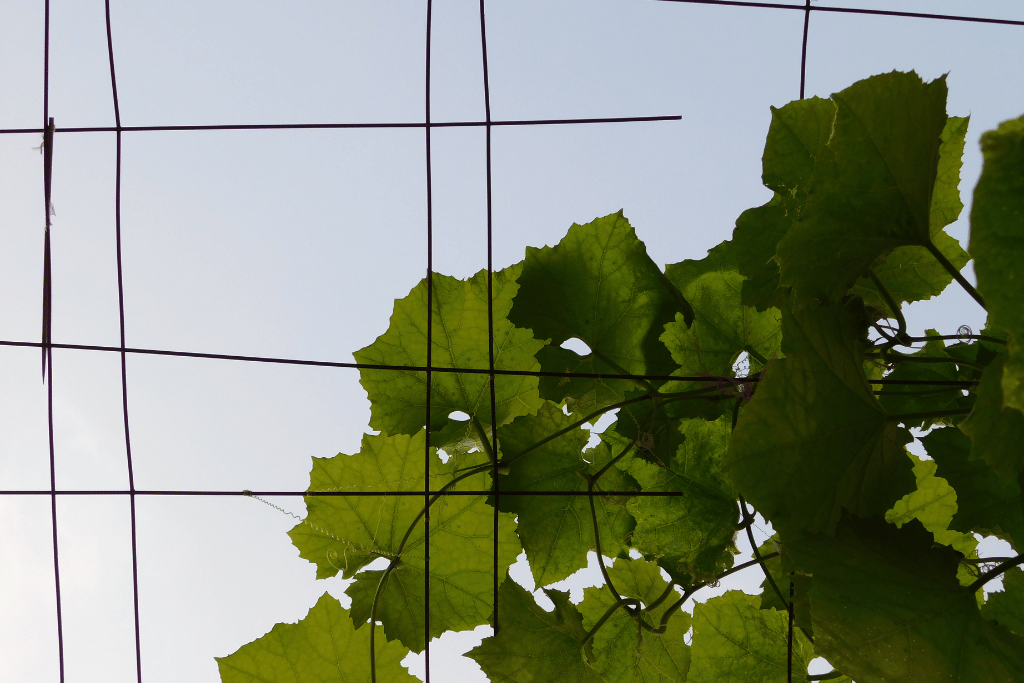
While trellising is a popular method for supporting zucchini plants, it’s not the only option available to gardeners. Staking and caging are two alternative support methods that can be employed to help your zucchini thrive. These methods offer their own unique advantages and considerations.
Staking Zucchini Plants
Staking zucchini plants involves providing vertical support by driving stakes into the ground next to each plant. This method is straightforward and can be an excellent choice for those who prefer a simpler approach. Here’s a closer look at staking zucchini plants:
Staking Pros:
Ease of Setup: Staking is relatively easy to set up. You only need sturdy stakes, which can be made of wood, metal, or other suitable materials, and garden tape or twine to secure the vines.
Space-Efficient: Staking saves horizontal space in the garden. It’s an excellent option for those with limited garden real estate.
Accessibility: Harvesting zucchini from staked plants is generally straightforward, as the fruits are often more accessible compared to sprawling vines.
Staking Cons:
Visual Impact: Staked zucchini plants can appear somewhat utilitarian and lack the lush, spreading appearance of untrellised or caged plants.
Support Limitations: Staking is best suited for bush-type zucchini varieties, as vining zucchinis may require more support than stakes can provide.
Maintenance: While staking is simpler than trellising, it still requires regular monitoring to ensure the vines remain secured to the stakes as they grow.
Caging Zucchini Plants
Caging zucchini plants involves using wire cages or tomato cages to provide support for the vines. This method is often chosen for its neat and organized appearance. Here’s a closer look at caging zucchini plants:
Caging Pros:
Aesthetically Pleasing: Caged zucchini plants tend to have a more visually pleasing appearance compared to staked or untrellised plants. The cages help maintain a tidy and orderly growth pattern.
Space-Efficient: Similar to staking, caging saves horizontal garden space, making it a viable option for smaller gardens.
Sturdy Support: Wire cages provide robust support for both bush and vining zucchini varieties, reducing the risk of the vines becoming too heavy.
Caging Cons:
Setup and Maintenance: Caging can be more involved in terms of setup and maintenance compared to staking. Ensuring the cage is positioned correctly around the young zucchini plant is crucial.
Limited Accessibility: While caged zucchini plants are easier to access than sprawling vines, harvesting can still be slightly more challenging compared to trellised plants.
Space Considerations: Ensure you have adequate space for the cages to accommodate the growth of your zucchini plants.
When Zucchini Doesn’t Need a Trellis?
While trellising, staking, and caging offer valuable support for zucchini plants, there are situations where trellising may be unnecessary or less suitable. Gardeners should carefully consider these factors before deciding not to use a trellis:
1. Limited Space:
When space constraints are not an issue: If you have ample horizontal garden space, you may opt to let your zucchini plants sprawl naturally. In such cases, the extra space allows for unhindered growth, but it’s important to manage the vines to prevent overcrowding.
2. Preference for Simplicity:
When trellising seems too complex: Some gardeners may prefer a straightforward gardening approach without the added task of trellising. Zucchini can still thrive when grown without a trellis if proper spacing and vine management are implemented.
Factors to Consider Before Deciding Not to Use a Trellis:
Before making the decision to forgo a trellis for your zucchini plants, consider the following factors:
1. Space:
Horizontal Space Requirement: Zucchini plants that are not trellised require more horizontal space in your garden. Ensure you have enough room for the vines to spread comfortably.
2. Effort:
Trellising Effort: While trellising can be time-consuming, it offers benefits such as improved air circulation and easier harvesting. Consider whether the effort aligns with your gardening goals and preferences.
3. Appearance:
Aesthetic Considerations: Untrellised zucchini plants can appear sprawling and less organized. If visual aesthetics are important to you, explore alternative support methods like staking or caging.
Alternative Planting Arrangements for Zucchini:
If you choose not to use a trellis for your zucchini plants, alternative planting arrangements can still help you achieve a successful harvest:
1. In Rows:
Row Planting: Plant zucchinis in rows, spacing them 2-3 feet apart to allow for their natural growth. This arrangement allows for easier management of sprawling vines.
2. In a Circle:
Circular Planting: Alternatively, you can plant zucchinis in a circular pattern, with plants spaced 3-4 feet apart. This circular layout can enhance the overall appearance of your garden.
While trellising remains a valuable option for zucchini support, these alternative methods, as well as trellis-free cultivation, provide flexibility for gardeners with various preferences and garden sizes. Ultimately, the choice of support method depends on your individual gardening goals and the unique conditions of your garden space.
Common Zucchini Growing Challenges and Solutions
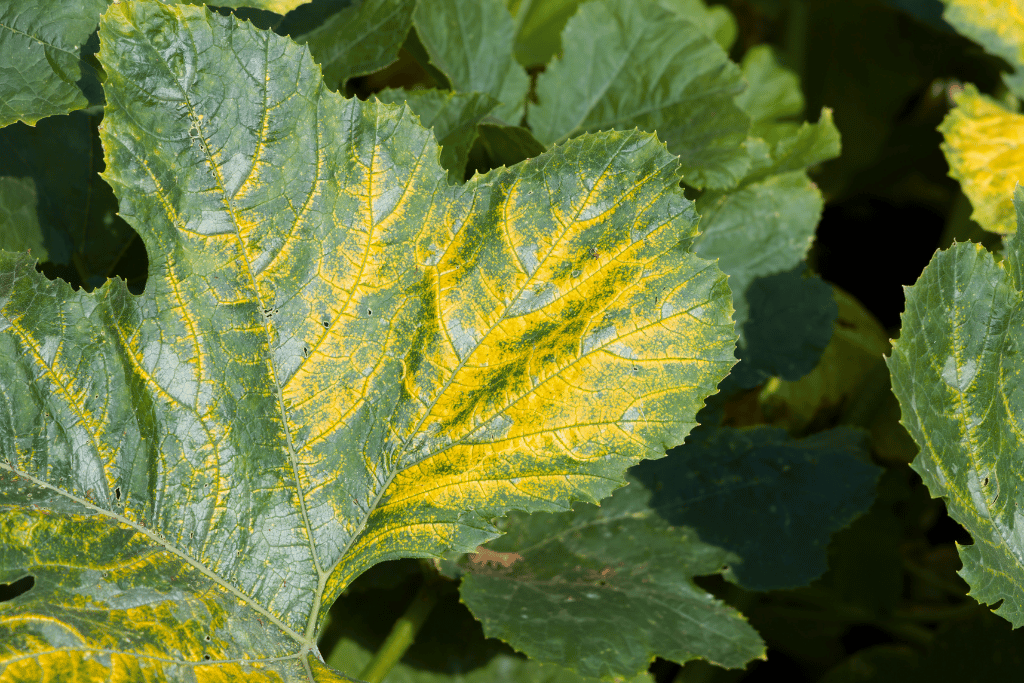
As with any garden crop, zucchinis can face their fair share of challenges during the growing season. However, by identifying and addressing these common issues early, you can help ensure a successful zucchini harvest. Here are some of the most encountered challenges and effective solutions to overcome them:
1. Pests and Diseases:
Challenge: Zucchini plants are susceptible to various pests, including aphids, squash bugs, cucumber beetles, and diseases like powdery mildew and bacterial wilt. These pests can damage the plants, reduce fruit production, and impact overall plant health.
Solution: Vigilance is key when it comes to managing pests and diseases. Regularly inspect your zucchini plants for any signs of trouble. Consider these measures:
Encourage natural predators like ladybugs and beneficial insects to help control pest populations.
You can also use neem oil or insecticidal soap to treat aphids and other soft-bodied insects. Follow the instructions on the product label.
Apart from that, you can practice crop rotation to reduce the risk of diseases. Avoid planting zucchinis in the same location as the previous year.
2. Overcrowding:
Challenge: Zucchini plants can become crowded if not properly spaced, which can lead to increased competition for nutrients, reduced air circulation, and higher susceptibility to disease.
Solution: Adequate spacing is essential to prevent overcrowding:
Ensure you follow the recommended plant spacing for zucchinis, typically 2-3 feet apart, depending on the variety. If you’ve planted zucchini seeds too closely, thin them out by removing excess seedlings to achieve the proper spacing.
3. Fertilization Issues:
Challenge: Inadequate or excessive fertilization can affect zucchini plant health and productivity. Nutrient deficiencies can lead to poor fruit development, while over-fertilization can result in excessive foliage growth with fewer fruits.
Solution: Proper fertilization is crucial:
Conduct a soil test to determine nutrient levels in your garden soil. This can guide your fertilization strategy.
Moreover, you can use a balanced, all-purpose fertilizer designed for vegetables and follow the recommended application rates. Apply fertilizer evenly around the base of the plants for best results.
4. Inadequate Pollination:
Challenge: Zucchinis require pollination by insects, particularly bees, to produce fruit. A lack of pollinators can lead to poor fruit development.
Solution: To improve pollination:
Include flowering plants in your garden that attract pollinators. Examples include marigolds and bee balm.
In the absence of sufficient pollinators, you can also hand-pollinate zucchini flowers. Gently transfer pollen from the male flowers (with pollen) to the female flowers (with small fruits at the base).
5. Overwatering or Underwatering:
Challenge: Inconsistent watering practices can lead to problems such as root rot (from overwatering) or wilting and poor fruit development (from underwatering).
Solution: Maintain proper soil moisture levels:
Water your zucchini plants consistently to keep the soil evenly moist, but not waterlogged. A soaker hose or drip irrigation system can help achieve uniform watering.
In addition to that, you can apply a layer of organic mulch, such as straw or compost, around the base of the plants to help retain soil moisture.
6. Poor Fruit Support:
Challenge: Zucchini fruits can become heavy as they grow, potentially causing them to bend or break the vines or even fall to the ground.
Solution: Proper fruit support can prevent these issues:
Place a net or mesh beneath the zucchini vines to catch the fruits as they mature. Or, create slings from fabric or netting and gently tie them around developing zucchini fruits to provide support.
You can also position bamboo stakes near the growing zucchini fruits and secure them to the stakes with twine or garden tape to distribute the weight.
7. Temperature Extremes:
Challenge: Zucchini plants are sensitive to temperature extremes. Cold temperatures can slow growth, while excessive heat can stress the plants.
Solution: Mitigate temperature-related challenges:
Use row covers to protect young zucchini plants from cold temperatures in early spring.
During heatwaves, provide shade with a breathable shade cloth to shield plants from excessive sun exposure.
Final Words
So, does zucchini need a trellis? No, but it can be a good idea to grow zucchini vertically, especially if you have a small garden or want to make harvesting easier. Just make sure to choose a strong trellis and train the plants carefully.
FAQs about Growing Zucchini on a Trellis:
Will zucchini climb a trellis if I train them?
Yes, zucchini plants can be trained to climb a trellis if you provide them with proper support and guidance. While they are not natural climbers like some other vegetables, you can gently tie their vines to the trellis as they grow to encourage upward growth.
Will zucchini grow on a trellis if I have limited space in my garden?
Absolutely! Growing zucchini on a trellis is an excellent space-saving technique. It allows you to maximize vertical space in your garden, making it ideal for small or limited gardening areas.
Can all zucchini varieties be grown on a trellis?
Most zucchini varieties can be grown on a trellis with the right support. However, it’s essential to choose compact or bush varieties for trellising to ensure they don’t become too heavy or unmanageable for the structure.
Will growing zucchini on a trellis affect the quality of the fruit?
Growing zucchini on a trellis typically doesn’t affect the quality of the fruit. In fact, it can help reduce the risk of fruit rot and make harvesting easier since the fruit won’t touch the ground.
Do I need to provide additional support for zucchini fruits on the trellis?
Zucchini fruits are usually self-supporting on the trellis as long as you secure the main vine properly. However, you can use slings or soft fabric to cradle and support larger fruits to prevent them from breaking off.



